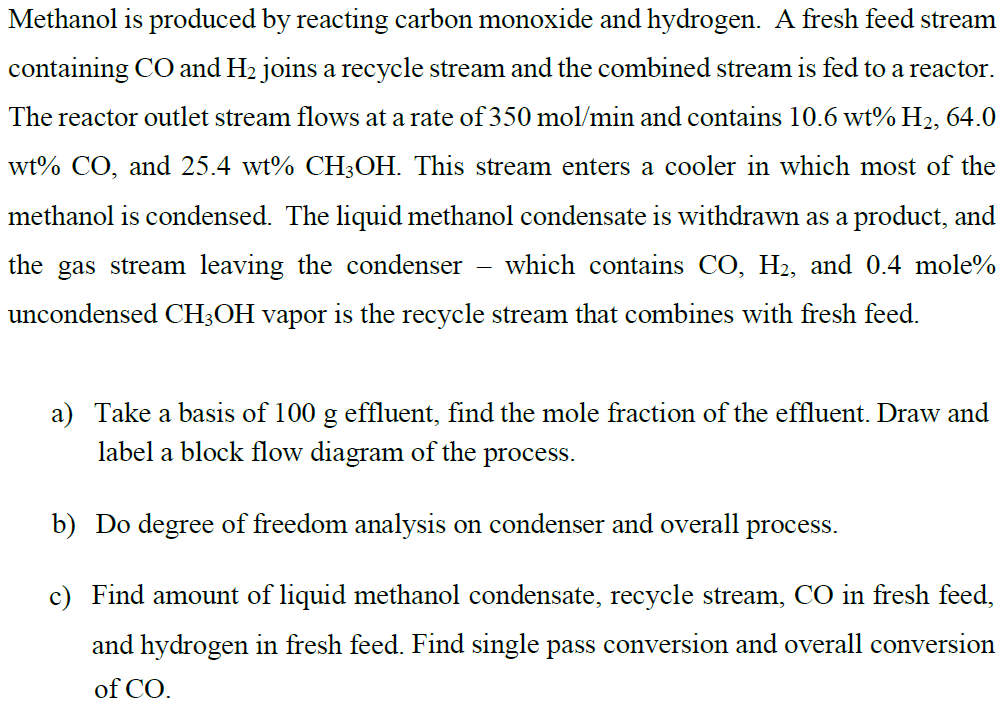Methanol is produced by reacting carbon monoxide and hydrogen. A fresh feed stream containing CO and H2 joins a recycle stream and the combined stream is fed to a reactor. The reactor outlet stream flows at a rate of 350 mol/min and contains 10.6 wt% H2, 64.0 wt% CO, and 25.4 wt% CH;OH. This stream enters a cooler in which most of the methanol is condensed. The liquid methanol condensate is withdrawn as a product, and the gas stream leaving the condenser – which contains CO, H2, and 0.4 mole% uncondensed CH;OH vapor is the recycle stream that combines with fresh feed. a) Take a basis of 100 g effluent, find the mole fraction of the effluent. Draw and label a block flow diagram of the process. b) Do degree of freedom analysis on condenser and overall process. c) Find amount of liquid methanol condensate, recycle stream, CO in fresh feed, and hydrogen in fresh feed. Find single pass conversion and overall conversion of CO.
Methanol is produced by reacting carbon monoxide and hydrogen. A fresh feed stream containing CO and H2 joins a recycle stream and the combined stream is fed to a reactor. The reactor outlet stream flows at a rate of 350 mol/min and contains 10.6 wt% H2, 64.0 wt% CO, and 25.4 wt% CH;OH. This stream enters a cooler in which most of the methanol is condensed. The liquid methanol condensate is withdrawn as a product, and the gas stream leaving the condenser – which contains CO, H2, and 0.4 mole% uncondensed CH;OH vapor is the recycle stream that combines with fresh feed. a) Take a basis of 100 g effluent, find the mole fraction of the effluent. Draw and label a block flow diagram of the process. b) Do degree of freedom analysis on condenser and overall process. c) Find amount of liquid methanol condensate, recycle stream, CO in fresh feed, and hydrogen in fresh feed. Find single pass conversion and overall conversion of CO.
Introduction to Chemical Engineering Thermodynamics
8th Edition
ISBN:9781259696527
Author:J.M. Smith Termodinamica en ingenieria quimica, Hendrick C Van Ness, Michael Abbott, Mark Swihart
Publisher:J.M. Smith Termodinamica en ingenieria quimica, Hendrick C Van Ness, Michael Abbott, Mark Swihart
Chapter1: Introduction
Section: Chapter Questions
Problem 1.1P
Related questions
Question
Please answer all parts

Transcribed Image Text:Methanol is produced by reacting carbon monoxide and hydrogen. A fresh feed stream
containing CO and H2 joins a recycle stream and the combined stream is fed to a reactor.
The reactor outlet stream flows at a rate of 350 mol/min and contains 10.6 wt% H2, 64.0
wt% CO, and 25.4 wt% CH;OH. This stream enters a cooler in which most of the
methanol is condensed. The liquid methanol condensate is withdrawn as a product, and
the gas stream leaving the condenser –
which contains CO, H2, and 0.4 mole%
uncondensed CH;OH vapor is the recycle stream that combines with fresh feed.
a) Take a basis of 100 g effluent, find the mole fraction of the effluent. Draw and
label a block flow diagram of the process.
b) Do degree of freedom analysis on condenser and overall process.
c) Find amount of liquid methanol condensate, recycle stream, CO in fresh feed,
and hydrogen in fresh feed. Find single pass conversion and overall conversion
of CO.
Expert Solution
Trending now
This is a popular solution!
Step by step
Solved in 9 steps with 13 images

Knowledge Booster
Learn more about
Need a deep-dive on the concept behind this application? Look no further. Learn more about this topic, chemical-engineering and related others by exploring similar questions and additional content below.Recommended textbooks for you

Introduction to Chemical Engineering Thermodynami…
Chemical Engineering
ISBN:
9781259696527
Author:
J.M. Smith Termodinamica en ingenieria quimica, Hendrick C Van Ness, Michael Abbott, Mark Swihart
Publisher:
McGraw-Hill Education

Elementary Principles of Chemical Processes, Bind…
Chemical Engineering
ISBN:
9781118431221
Author:
Richard M. Felder, Ronald W. Rousseau, Lisa G. Bullard
Publisher:
WILEY

Elements of Chemical Reaction Engineering (5th Ed…
Chemical Engineering
ISBN:
9780133887518
Author:
H. Scott Fogler
Publisher:
Prentice Hall

Introduction to Chemical Engineering Thermodynami…
Chemical Engineering
ISBN:
9781259696527
Author:
J.M. Smith Termodinamica en ingenieria quimica, Hendrick C Van Ness, Michael Abbott, Mark Swihart
Publisher:
McGraw-Hill Education

Elementary Principles of Chemical Processes, Bind…
Chemical Engineering
ISBN:
9781118431221
Author:
Richard M. Felder, Ronald W. Rousseau, Lisa G. Bullard
Publisher:
WILEY

Elements of Chemical Reaction Engineering (5th Ed…
Chemical Engineering
ISBN:
9780133887518
Author:
H. Scott Fogler
Publisher:
Prentice Hall


Industrial Plastics: Theory and Applications
Chemical Engineering
ISBN:
9781285061238
Author:
Lokensgard, Erik
Publisher:
Delmar Cengage Learning

Unit Operations of Chemical Engineering
Chemical Engineering
ISBN:
9780072848236
Author:
Warren McCabe, Julian C. Smith, Peter Harriott
Publisher:
McGraw-Hill Companies, The